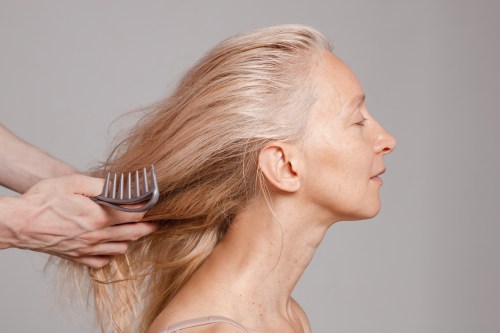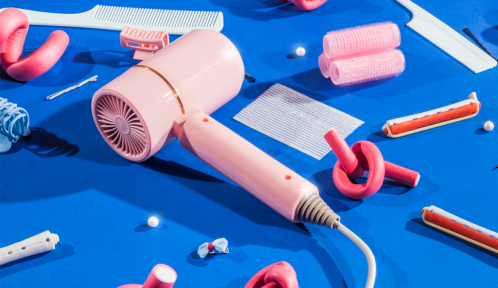Our editors independently select these products. Making a purchase through our links may earn Well+Good a commission
This Hot Oil Treatment for Hair Helps No Matter What Issue You’re Dealing With
Whether you're dealing with dry strands or an itchy or oily scalp, a hot oil treatment for hair can help. Here's everything you need to know.

The hair-care market is saturated with products that promise to make your hair stronger, shinier, and hydrated. But the best way to get all three at the same time is a hot oil treatment for hair.
Experts in This Article
LA-based hairstylist and founder of Rejuvagrow Hair Care
celebrity hairstylist and artistic director for Mizani
What is a hot oil treatment for hair?
A hot oil treatment involves using heated oil to nourish your hair from root to tip. The heat helps to make it more effective than if you were simply slathering on the product at room temperature. “Hot oil treatments for hair work by allowing hot dry or wet heat to expand your hair,” says celebrity hairstylist Malaika Frazier. “When you apply the hot oil from scalp to the ends, the strands are are able to absorb the oils and nutrients At least 30 to 40 percent more than they would with a normal, dry application without any heat.”
And why is that? “The heat helps to refine the oil making the molecules finer to penetrate the hair strand,” explains celebrity hair stylist Tippi Shorter.
Benefits of hot oil treatments for hair
Research has shown that oils, in general, “protect the hair from damage by penetrating the hair shaft, reducing the amount of water the hair can absorb, which prevents swelling at the hair shaft,” says Debbi Burnes, founder of Sumbody. Since your strands are able to better absorb the nutrients from hot oils than cold ones, there’s an obvious pro to heating up your product before applying it. Any sort of oil will moisturize your hair and scalp, and since your body is able to absorb the nutrients from hot oils better than cold or room temperature ones, hot oil treatments add a serious boost of protection and hydration.
Beyond that, though, different oils offer different benefits for your hair, so it’s about choosing the right one for your specific needs. Just be sure you’re not using anything you’re allergic to (you can patch test on your arm before applying to your hair), and cut harsher oils like peppermint and rosemary with something softer, like jojoba or avocado. A few stylist-favorite options:
The best hot oils to treat different types of hair
1. Peppermint oil
If you’ve got an itchy scalp, or your hair tends to get overly greasy, reach for some peppermint oil, which has clarifying properties that will help do away with buildup and dead skin cells.
2. Argan oil
Often referred to as “liquid gold” in the hair-care world, argan oil is great for smoothing and moisturizing strands while also stimulating hair growth and helping to prevent future breakage.
3. Hemp seed oil
For overly dry strands, hemp seed oil is a great, moisturizing pick. It has one of the highest concentrations of polyunsaturated fatty acids of all naturally occurring oils, and will lock moisture into your hair follicle.
4. Avocado oil
Dealing with frizz? Avocado oil can help tame it. Since it’s a light oil (which is one of the reasons it’s so popular in healthy recipes), it will keep strands smooth without leaving behind any sort of slick residue.
5. Coconut oil
Coconut oil is among the most popular hair oil treatments out there, and for good reason. It moisturizes and smooths strands and may even help them grow, which explains why it’s such a fan favorite among all hair types.
6. Olive oil
Your hair is able to absorb monosaturated oils, like olive oil, better than polysaturated ones, making this a great choice for keeping hair shiny, soft, and safe from damage.
7. Almond oil
Almond oil is packed with good-for-hair elements—including omega-3 fatty acids, phospholipids, vitamin E, and magnesium—which will help strengthen and nourish your strands while also keeping frizz at a minimum.
8. Rosemary oil
Looking for more hair on your head? Try some rosemary oil. Research has shown that when massaged into your scalp daily, it can protect against hair lossandhelp with hair growth—a double whammy for upping your strand count.
While you can certainly mix up these ingredients into a treatment of your own, there are plenty of products on the market that do the job for you and already include them. Shorter is a fan of Mizani 25 Miracle Oil ($22), which includes coconut, jojoba, and sunflower seed oils, which isn’t technically a hot oil treatment but she heats up to make it more effective. Frazier exclusively uses Rejuvagrow Hair Oil ($20). “It’s filled with nutrients that provide a pH balance for your scalp and hair strands,” she says. “It’s very lightweight so it won’t weigh your hair down no matter how thick or thin it is.”
Who should use a hot oil treatment?
Since there are so many different oil options that each have their own benefits, there’s really something for all hair types and textures when it comes to hot oil treatments.” Everyone can truly benefit from a hot oil because of the scalp benefits however, people with textured hair do benefit most,” says Frazier. “Textured hair tends to be more porous and doesn’t fully reap the benefits from the natural oils the scalp secretes, because oils don’t easily slide down the hair shaft of textured hair as it does for straight hair.” Shorter adds that anyone with extremely dry, damaged, or chemically treated hair can also benefit from dousing their strands in hot oil.
How to do a hot oil treatment
1. Prep your hair
Deciding whether you want to do a hot oil treatment on wet or dry hair depends on your hair type. If your hair is extremely thick or dry, Shorter recommends applying to dry hair, while medium or fine hair should be treated wet.
2. Heat your oil
If you purchase a pro-grade hot oil treatment, just follow the directions on the back of the bottle to get the product nice and warm. If you’re doing it yourself, you can warm the bottle in your hands or put a few teaspoons in a bowl and nuke it in the microwave for 10-15 seconds.
3. Let the product sit
Depending on how much love your hair needs, you can either apply it immediately before you shampoo for 10 to 15 minutes, or let it sit overnight and wash it out in the morning. Frazier suggests parting your hair into four different sections and pulling the oil from your scalp down to the ends. Then, let it sit under a plastic shower cap, or if you’ve got them, a hair steamer or hood dryer.
6. Wash it out
After you’ve let the hot oil treatment sit (for however long you choose), rinse it out with water, then shampoo and condition normally.
7. Repeat as needed
Depending on how much love your hair needs, you can treat it to some hot oil once a week or once every two weeks.










